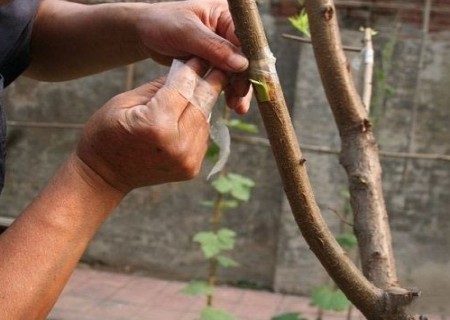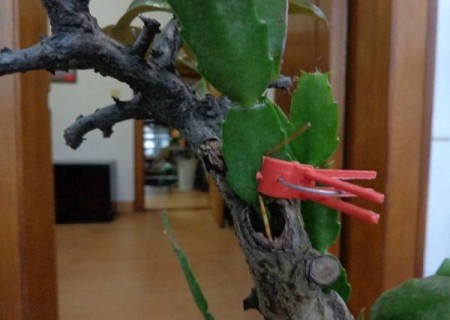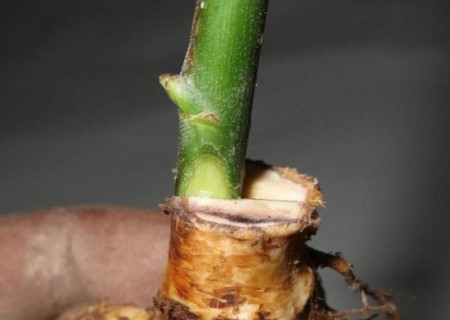Diagram of branch grafting method of bonsai
Seedling grafting propagation means that the branches or buds of one plant are grafted on another plant, so that the two parts connected together become a complete plant. The branches or buds grafted are called scions, and the grounded plants are called rootstocks. Grafting is divided into two categories: branch grafting and bud grafting, with branches as scions and buds as scions.

Branch grafting is a grafting method using plant branches as scions, usually when the sap begins to flow and the cortex has not been peeled off in spring, or when the cortex of the rootstock is peeled off but the scion has not yet sprouted (that is, before and after the sting of Grain Rain). The commonly used grafting techniques are cutting, splitting, skin grafting, tongue grafting and so on.
First, the best time for branch grafting
Branch grafting is generally carried out in the dormant period of seedlings, mostly in spring and winter, but spring is the best season. The temperature increases gradually after spring grafting, which is beneficial to healing, and then it can sprout and grow.
1. Spring branch grafting: spring is generally the best from March 20 to April 10, when the sap of rootstock and scion has begun to flow, the cell division is active, the interface heals quickly, and the survival rate of grafting is high. The tree species that germinate later, such as black jujube grafted persimmon and walnut, should be later, and it will be better after April 20, that is, it is most suitable from Grain Rain to the Beginning of Summer.
2. Summer branch grafting: the grafting of evergreen trees is more suitable in summer, such as dragon cypress, green cypress, Sajinbai and so on, the survival rate of grafting is higher in June.
3. Winter branch grafting: both rootstock and scion are dormant in winter, and the metabolic activity of cell tissue is very weak. the key to survival after grafting lies in the quality of pseudo-planting, rootstock and scion can not lose too much water. The branch grafting in winter is carried out indoors by taking advantage of the leisure time in winter; after being picked up, it is pseudo-planted in the cellar and planted in the field in spring. In the process of false planting and transplantation, because the interface has not yet healed, touch the interface, affecting the survival. The grafted dormant seedlings can also be maintained in the greenhouse to make them heal and sprout ahead of time. The advantage of winter grafting is to use the dormant period of tree grafting, regardless of the seasonality of growth, the time is leisurely, the whole winter can be carried out. Can make full use of winter leisure for production and improve production efficiency.
2. Grafting process / method
1. Choose the plant varieties and rootstocks you want to graft.
In order to be successfully grafted, you must cut a scion (a small piece for grafting) from a healthy disease-free plant variety (source tree) and a suitable growing tree (rootstock). Grafting can only be used for rootstocks and scions of the same diameter, and the diameter must be between 0.6 and 1.3 cm. Grafting must not begin until the severe cold threatens to pass, but also before the bark of the trunk begins to slide. The scion must be dormant (unsprouted) and should be a branchlet 0.3 meters long with three to five buds on it.
2. Prepare scion
Remove the end of the scion. On the basis of the scion, tilt the end.
3. Prepare rootstocks
Choose a branch that matches your scion for oblique cutting. The two must be combined.
4. Make a tongue incision
Cut a tongue-shaped wedge on the section of the rootstock and scion so that they match in this way so that they can hook up with each other.
5. Use scion
Place the scion slightly off the rootstock and slide down so that the two overlap. Make sure the green layer under the bark of both trees is aligned, otherwise the grafting will not be successful.
6. Fixed scion
Wrap an elastic rubber material around the rootstock to control the buds in place. The effect of grafting tape is very good. If you are using a different material, be sure to remove it within a month.
7. Take care of grafting
Everything that grows under the grafted branch is removed, except that the leaflets can be left behind until the grafted branch can successfully absorb the nutrients delivered to the tree.
Time: 2019-06-09 Click:
- Prev

Grafting Technique Illustration of Bonsai
What is grafting? Grafting is the grafting of part of a plant, such as a bud or branch, onto the stem or root of another plant so that the two parts can heal together and grow into a complete plant. The bud or branch attached is called scion (commonly known as code)
- Next

Diagram of T-shaped bud grafting of bonsai
The bud grafting method refers to the grafting method of the scion with a bud with cambium. This method must ensure that the scion is only robust and pest-free. It should be noted that the survival rate of the plant should be recorded at any time after the grafting is completed. If it is found that the bud is germinating, the bud should be released from the wrapping film in time.
Related
- Fuxing push coffee new agricultural production and marketing class: lack of small-scale processing plants
- Jujube rice field leisure farm deep ploughing Yilan for five years to create a space for organic food and play
- Nongyu Farm-A trial of organic papaya for brave women with advanced technology
- Four points for attention in the prevention and control of diseases and insect pests of edible fungi
- How to add nutrient solution to Edible Fungi
- Is there any good way to control edible fungus mites?
- Open Inoculation Technology of Edible Fungi
- Is there any clever way to use fertilizer for edible fungus in winter?
- What agents are used to kill the pathogens of edible fungi in the mushroom shed?
- Rapid drying of Edible Fungi

